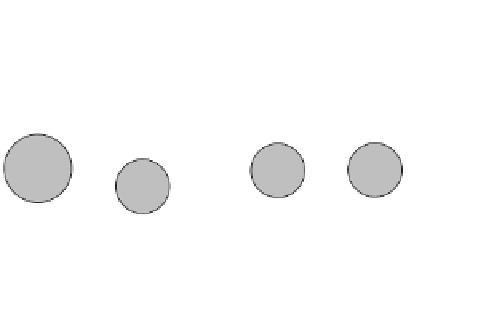Environmental Engineering Reference
In-Depth Information
High-quality matter
is concentrated, is typically found
near the earth's surface, and has great potential for use
as a matter resource.
Low-quality matter
is dilute, is
often located deep underground or dispersed in the
ocean or the atmosphere, and has little potential for
use as a material resource.
An aluminum can is a more concentrated, higher-
quality form of aluminum than aluminum ore contain-
ing the same amount of aluminum. It takes less energy,
water, and money to recycle an aluminum can than to
make a new can from aluminum ore.
Material efficiency,
or
resource productivity,
is
the total amount of material needed to produce each
unit of goods or services. Business expert Paul
Hawken and physicist Amory Lovins contend that re-
source productivity in developed countries could be
improved by 75-90% within two decades using exist-
ing technologies.
The Law of Conservation of Matter
When a physical or chemical change occurs, no atoms
are created or destroyed.
We may change elements and compounds from one physical
or chemical form to another, but we can never create or de-
stroy any of the atoms involved in any physical or chemical
change.
All we can do is rearrange the elements and
compounds into different spatial patterns (physical
changes) or combinations (chemical changes). This
finding, based on many thousands of measurements,
is known as the
law of conservation of matter.
In de-
scribing chemical reactions, chemists use a shorthand
system to account for all of the atoms, which they then
use to balance chemical equations. See Science Supple-
ment 4 at the end of this topic for information on how
to balance chemical equations.
The law of conservation of matter means there is
no “away” in “to throw away.” Everything we think we
have thrown away remains here with us in some form.
We can collect dust and soot from the smokestacks of
industrial plants, but these solid wastes must then be
put somewhere. We can remove substances from pol-
luted water at a sewage treatment plant, but then we
must burn them (producing some air pollution), bury
them (possibly contaminating underground water sup-
plies), or clean them up and apply the gooey sludge to
the land as fertilizer (dangerous if the sludge contains
toxic metals such as lead and mercury).
Physical and Chemical Changes
Matter can change from one physical form to another
or change its chemical composition.
When a sample of matter undergoes a
physical change,
its chemical composition does not change. For exam-
ple, a piece of aluminum foil cut into small pieces is still
aluminum foil. When solid water (ice) melts or liquid
water boils, none of the H
2
O molecules involved
changes; instead, the molecules are organized in differ-
ent spatial (physical) patterns.
In a
chemical change,
or
chemical reaction,
the
chemical compositions of elements or compounds
change. Chemists use shorthand chemical equations to
represent what happens in a chemical reaction. For
example, when coal burns completely, the solid carbon
(C) in the coal combines with oxygen gas (O
2
) from the
atmosphere to form the gaseous compound carbon
dioxide (CO
2
).
Types of Pollutants
The law of conservation of matter says that we
will always produce some pollutants, but we can
produce much less and clean up some of what we do
produce.
We can make the environment cleaner and convert
some potentially harmful chemicals into less harmful
physical or chemical forms. But
the law of conservation
of matter means we will always face the problem of what to
do with some quantity of wastes and pollutants.
Three factors determine the severity of a pollu-
tant's harmful effects: its
chemical nature,
its
concentra-
tion,
and its
persistence.
Concentration is sometimes expressed in terms of
parts per million (ppm),
where 1 ppm corresponds to
1 part pollutant per 1 million parts of the gas, liquid, or
solid mixture in which the pollutant is found. Smaller
concentration units are parts per billion (ppb) and
parts per trillion (ppt). Although we can reduce the
concentration of a pollutant by dumping it into the air
or into a large volume of water, there are limits to the
effectiveness of this dilution approach. For example,
the water flowing in a river can dilute or disperse
some of the wastes dumped into it. If we dump in too
much waste, however, this natural cleansing process
does not work.
Reactant(s)
Product(s)
energy
carbon
+
oxygen
carbon dioxide
+
C+
O
2
+
energy
CO
2
O
C
+
+
energy
O
C
O
O
black solid
colorless gas
colorless gas
Energy is given off in this reaction, which explains
why coal is a useful fuel. The reaction also shows how
the complete burning of coal (or any of the carbon-
containing compounds in wood, natural gas, oil, and
gasoline) produces carbon dioxide. This gas helps
warm the lower atmosphere (troposphere).






